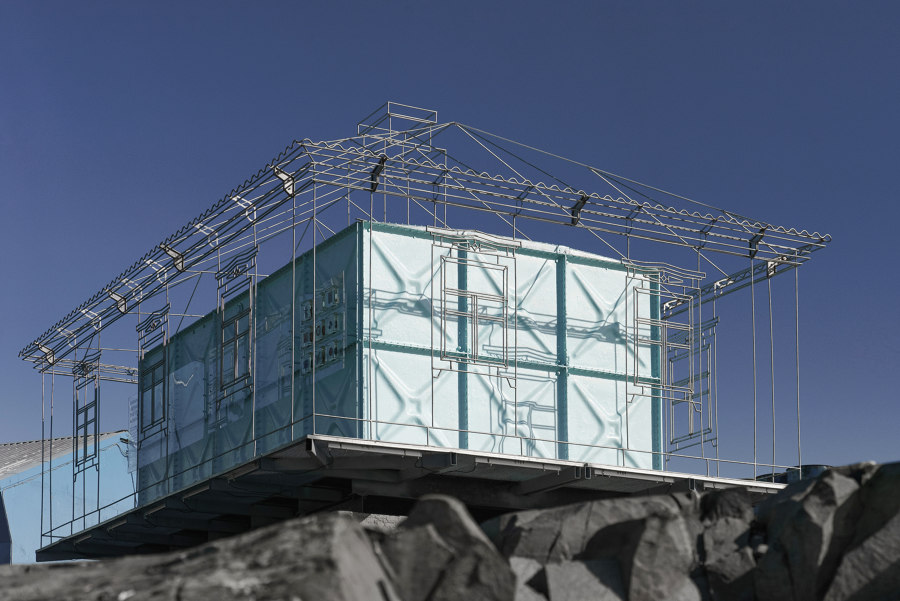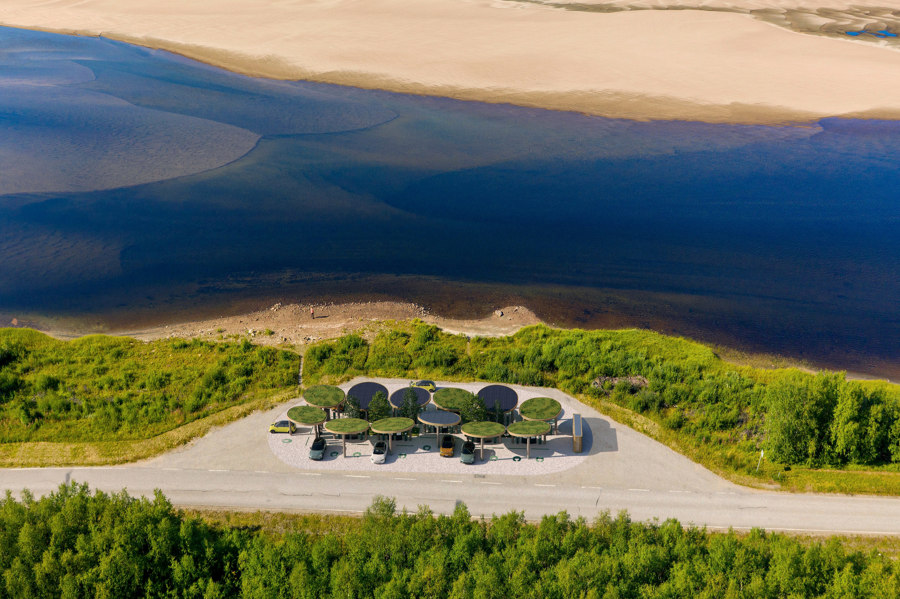Life is temporary: outdoor installations that highlight the transient nature of humanity
Text by James Wormald
08.05.23
Bookmarking the diameter of the planet, these temporary and longer-term installations serve to reference time by researching, recording, lengthening and improving our short-lived human existence.
Life is tough on Ukraine’s Vernadsky polar research base. The Home Memories installation brings visual comfort by sketching the outline of a traditional Ukrainian home. Photo: Slava Balbek

Life is tough on Ukraine’s Vernadsky polar research base. The Home Memories installation brings visual comfort by sketching the outline of a traditional Ukrainian home. Photo: Slava Balbek
×Einstein’s Special Theory of Relativity introduces the mind-blowing concept that time – as we know it – is not as stable and reliable as it first seems. As a defining characteristic upon which all of human history is referenced, the fallibility of time is a confusing prospect. 15 minutes, for example, seems an eternity while waiting in line, and yet the 300,000 years of human history equates to less than a day in the lifetime of the Earth.
Humanity itself is only a temporary installation
So when we talk about ‘saving the planet’ by slowing and reversing climate change, what we really mean is extending our own existence upon it. Because no matter what we do, this rock will continue to spin for billions of years yet. In reality, humanity itself is only a temporary installation. These four outdoor installation projects use the Earth’s environments and borrow its resources to investigate our human relationship with time, and how it affects our lives down here on the surface.
Up to 15 months away from home, many of them in complete darkness, researchers at the isolated Vernadksy station welcome the installation’s typical sight of home. Photos: Slava Balbek

Up to 15 months away from home, many of them in complete darkness, researchers at the isolated Vernadksy station welcome the installation’s typical sight of home. Photos: Slava Balbek
×Home Memories Installation at the Vernadsky Research Base, Antarctica by balbek bureau
Research stations in the Antarctic perform vital scientific research into not only the history of the planet by analysing its vintage tundra, but also frontline research into our future by investigating changes in the Antarctic climate. But life in the isolation of a polar research camp can be tough, with longer-term contracts lasting up to 15 months at a time. Kyiv-based architects balbek bureau repurposed a defunct fuel tank at the Ukrainian Vernadsky base into an installation that brings the visual comfort of home to its inhabitants.
Life in the isolation of a polar research camp be tough, with longer-term contracts lasting up to 15 months
‘Envisioning the station as a home away from home,’ explain balbek bureau, they based the Home Memories installation ‘on a composite image of a Ukrainian rural house.’ Like a museum of home, the installation also includes souvenir objects and materials from Ukraine, such as painted ceramics, embedded in resin. The hardwearing installation had to be easily transported and assembled, resistant to harsh weather conditions and safe for the island’s 3,500 penguin population, too.
As a New Year’s Eve installation, Falling Hours depicts the falling sands of time, before melting away to rejoin the sea. Photos: Arch-exist (top), BIAD (middle), Aranya | Tree Studio (bottom)

As a New Year’s Eve installation, Falling Hours depicts the falling sands of time, before melting away to rejoin the sea. Photos: Arch-exist (top), BIAD (middle), Aranya | Tree Studio (bottom)
×Falling Hours on Aranya Beach, China’s Gold Coast, Qinhuangdao, China by BIAD
The Falling Hours installation on Aranya Beach invites New Year’s Eve revellers to pour sand taken from the surrounding beach into a funnel, balanced above the circular ice structure. With the passing of midnight – a perceived period of renewal – the group collectively opens the hourglass and allows the collected sands to flow down into the space, before scribing their hopes and dreams for the coming year onto the membrane above.
In seemingly a metaphor for all of human existence, the bulk of the structure then returns from whence it came. ‘As time passes,’ explains the architects BIAD, ‘the sand returns to the beach, the ice melts into the ocean, and there leaves only one membrane to document the New Year’s Eve memories of Aranya 2023.’
An inverted sundial, Sun Path positions sculptural lines and objects at ground level to spotlight significant moments of Islamic history. Photos: Ali Ismail Karimi (top, middle), Laurian Ghinitoiu (bottom)

An inverted sundial, Sun Path positions sculptural lines and objects at ground level to spotlight significant moments of Islamic history. Photos: Ali Ismail Karimi (top, middle), Laurian Ghinitoiu (bottom)
×Sun Path, Rajab to Shawwal 1444 in Yidda, Saudi Arabia by Civil Architecture
Solely represented by the position of the sun, rather than the estimated timekeeping of a 24-hour day or 365/6-day calendar, sundials are still amongst the most accurate representations of time we have. In another installation that represents the passage of time and the lack of control humanity has over it, Civil Architecture’s Sun Path is a huge 2400 sqm canopy with careful openings that acts like an inverted sundial.
The resulting sunbeam ‘passes over lines on the ground corresponding to hours, months and seasons, as well as sculptural objects which indicate significant moments in Islamic history,’ explain the architects of the concept. ‘Our sense of the sun’s movement and the colour of the sky provide a general indication of the hour, in contrast to the abstract notion of time created by digital clocks.’
Greenstation’s concept EV charging stations reconnect drivers with their local environments, offering local product vending machines, maps of local walks and free-use equipment. Photos: Artishot

Greenstation’s concept EV charging stations reconnect drivers with their local environments, offering local product vending machines, maps of local walks and free-use equipment. Photos: Artishot
×Greenstation EV charging stations in Norway by Local
With the average time taken to charge EV batteries to a usable level around 30 minutes, even on a rapid charge, pausing motorists need something to occupy their minds other than staring at the gauge and wondering if they want a chocolate bar. Some welcome the opportunity to stretch their legs and empty the tank at a comfort stop, of course, and modern service stations seem more like shopping malls with food outlets, comfortable seating and free wi-fi making the wait even easier, but isn’t tarmacking over the landscape sort of against the environmental point?
The average time taken to charge EV batteries to a usable level is around 30 minutes
Lowering charging times would undoubtedly speed up our transition to emissions-free transport, but while we wait for the technology to catch up, we can help ourselves by changing our mindset. Norway’s Greenstation concept EV charging stations provide between 2-24 charging points under vegetation- or solar-panel-topped wooden canopies that blend in with the local landscape, and can offer ‘a digital map showcasing local hikes and places of interest within a 15-minute walking radius,’ and other local and low-cost amenities, explain architects Local.
© Architonic
Head to the Architonic Magazine for more insights on the latest products, trends and practices in architecture and design.




















